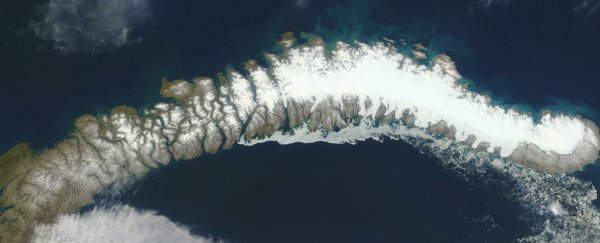Five new islands not previously known to exist have been discovered within the remote Arctic archipelago of Novaya Zemlya, the Russian navy has confirmed.
At a press conference marking the completion of a naval expedition that sailed as far north as Franz Josef Land, Vice Admiral Alexander Moiseyev of Russia's Northern Fleet explained the new islands were revealed by glaciers melting in the region.
"Mainly this is of course caused by changes to the ice situation," Moiseyev told media in Moscow.
"We thought they were (part of) the main glacier [called Vylki, aka Nansen]. Melting, collapse, and temperature changes led to these islands being uncovered."
The finding of the islands was first announced by the Russian Ministry of Defence in August, but in truth their discovery dates back to 2016, when student engineer Marina Migunova observed unknown land masses in satellite imagery while working on a research paper.
In the new expedition, naval researchers surveyed the topography of the five islands, which lie in Vize Bay at Novaya Zemlya's Severny Island, and are thought to have emerged from their icy coverings sometime around 2014.
In size, the islands range from very small to very large. Two are just tiny (the smallest measuring only 30 metres by 30 metres approximately), but the largest is expansive, covering a region of some 54,500 square metres.
As for the long-term stability of the newly revealed land masses, it's too early to say, since receding glaciers are known to destabilise the land that exists underneath them, as it loses a fortifying ice layer on top.
"Today, it is difficult to reach any conclusions about their importance and life span," Captain First Class Alexei Kornis, the head of the Northern Fleet Hydrographic Service, told the Russian site Arctic, noting that a glaciologist on the expedition suggested the islands might only last a decade or less.
But despite the clear land being only a few years old, life-forms have already colonised the young islands, with Kornis saying he'd observed algae, plant life, and birds, in addition to evidence of larger land animals in the fledgling ecosystem.
"We've found the remains of a seal torn up by a bear," Kornis said. "So, if all of this manages to take root, the islands will survive."
What is certain is that as the world gets increasingly hotter in response to anthropogenic global warming, these five islands are just among the early wave of sweeping surface transformations in Earth's melting polar regions.
Driving the point home, the Russian naval expedition – in waters that not long ago were too icy to freely navigate – didn't just confirm the discovery of five new islands on their voyage.
During the trip, a sixth previously unknown land mass was also discovered, located in a newly formed strait within the Franz Josef Land archipelago: a new island that had previously been mistaken as part of an existing peninsula.
According to the Russian navy, these new islands are not alone, joining a list of at least a dozen new islands that have emerged in the Arctic region in the past few years – a phenomenon so vast, even Russian schoolchildren are discovering islands.
In light of the way things are in the world, we should not be shocked, scientists say.
"The discovery of islands as the Nansen glacier retreats is not a surprise as a glacier is simply a river of ice transporting compacted snow and ice from the higher grounds to the sea," oceanographer Tom Rippeth from Bangor University in Wales told Newsweek.
"As the climate warms, the glaciers shrink and expose the land below. This is yet another symptom of the enhanced warming being experienced in the Arctic – in this region the average temperature is some 5 to 6 degrees Celsius warmer in response to climate change."
